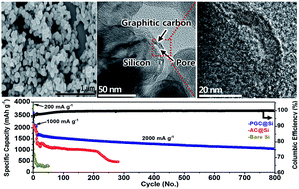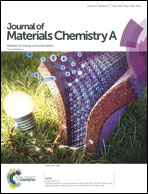A nanopore-embedded graphitic carbon shell on silicon anode for high performance lithium ion batteries†
Abstract
Silicon (Si) is a promising anode candidate for next generation lithium ion batteries (LIBs) due to its high theoretical specific capacity, low discharge potential, and abundance in nature. However, the large volume change during the lithiation/delithiation process causes pulverization and electrical connectivity loss. To resolve the issues associated with Si anodes, composites with graphene or its derivatives have been extensively studied, and a conformal graphitic carbon coating with well-defined internal void spaces is reported to be very effective to improve the cycle life and coulombic efficiency of Si anodes. Here, we develop a method to encapsulate Si nanoparticles with nano-porous N-doped graphitic carbon through Fe3+-mediated polymerization of dopamine, followed by subsequent carbonization and acid treatment and investigate their electrochemical performance as an anode for LIBs. Indeed, the as-synthesized 50 nm-sized Si nanoparticles with a graphitic carbon shell of 10 nm thickness exhibit excellent high rate capability and long cycle stability, delivering a high capacity of 1056 mA h g−1 after 800 cycles at a high current density of 2000 mA g−1, which is attributed to the high electrical conductivity, high Li+ ion mobility, and structural stability of nano-pore embedded, N-doped graphitic carbon coated Si (PGC@Si). For the feasibility of practical use, a full cell consisting of the as-synthesized PGC@Si anode and commercially available LiNi0.6Co0.2O2 (NCM) cathode is assembled and its electrochemical performance is examined.



 Please wait while we load your content...
Please wait while we load your content...